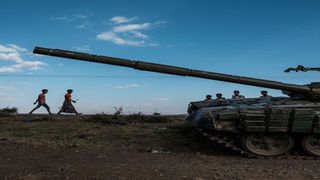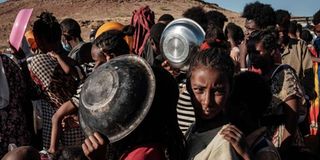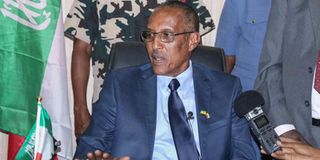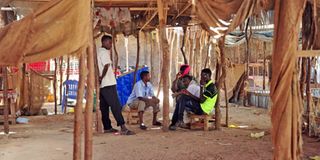
Youngsters walk next to an abandoned tank belonging to Tigrayan forces south of the town of Mehoni, Ethiopia on December 11, 2020.
| Eduardo Soteras | AFPNews
Premium
Regional stability at risk as Kenya’s neighbours in turmoil
Kenya has once again found itself in the middle of conflicts witnessed in countries across Eastern Africa, even as a number of experts warn that the clashes, if not resolved early, could weaken the stability of the region.
Uganda, Ethiopia, Somalia and Sudan have been experiencing internal conflicts tied to marginalisation, elections and regime changes that have stretched over months and even years, threatening the stability of a region previously dominated by peace and tranquillity.
In Uganda, President Yoweri Museveni has been facing a growing rebellion to his re-election bid from the bulging young population.
The group led by pop-star turned politician Robert Kyagulanyi alias Bobi Wine, has accused Mr Museveni of running down the country and stifling any opposition to his rule that spans over three decades.

Children who fled Ethiopia's Tigray conflict wait in a line for a food distribution by Muslim Aid at the Um Raquba refugee camp in Sudan's eastern Gedaref state on December 12, 2020.
Tigray conflict
Ethiopia’s Prime Minister Abiy Ahmed is also facing an internal conflict within the semi-autonomous Tigray region — an area that has been in conflict with the Ahmed administration since 2018, when the prime minister took office.
The conflict has already sucked in Sudan — a country facing its own conflicts being carried out by rebel forces that have for close to 17 years, accused the government in Khartoum, including that of toppled strongman, Omar al-Bashir, of political and economic marginalisation.
Prof Macharia Munene, a scholar in international relations, told the Nation that the conflicts currently being experienced in the region are tied to succession politics and a fight for regime change in countries such as Uganda, where President Museveni has been at the helm for 35 years.
“This is all part of a cycle in terms of regional changes and upheavals. It also appears to be a generational change, where the old guards, in an attempt to cling to power and retain their positions, are facing an increasingly hesitant younger generation,” said Prof Macharia.
The conflicts are not tied to the two countries alone.

Somaliland President Muse Bihi.
On Monday, President Uhuru Kenyatta hosted Somaliland leader Muse Bihi – the head of the breakaway self-declared country – at State House, to discuss what the Ministry of Foreign Affairs said were matters of mutual interest, including trade.
The visit by Mr Bihi, the first since the late former President Daniel Moi hosted the country’s head of government in 1994, has been termed by most analysts as consequential both for Kenya and the Horn of Africa state, which has been in the crosshairs of Somalia.
Seeking Kenya’s help
Dr Mustafa Ali, chairman of the Horn Institute, a policy think-tank on the affairs of the Horn of Africa region, said the visit by Mr Bihi, was to serve only one purpose — that of seeking Kenya’s help in its quest to become an independent state and a country.
“Somaliland President Bihi wants Kenya to recognise Somaliland as an independent state. And hopefully, because of Kenya’s stature as an anchor state in the region, a strong country in Africa, then in its calculation, it sees Kenya as a good ally to support its ambition,” he said.
Dr Ali said that this quest could be tied to the fact that Kenya has been on a charm offensive for a partner that would help it gain an influence over Somalia’s leadership that has proved elusive and distant from the Nairobi administration over time.
“Kenya’s leadership considers the current president in Mogadishu Mohamed Farmaajo as a very difficult president to deal with. Farmaajo has framed a very toxic narrative and a nasty discourse against Kenya, and therefore, Kenya is seeking support of Somaliland in ensuring that there’s a better relationship between Kenya and Somalia and Somaliland,” said Dr Ali.
Somalia had, in November, ordered the expulsion of Kenya’s ambassador after accusing the country of interfering in the electoral process in Jubaland, one of Somalia’s five semi-autonomous states.
Somalia also recalled its ambassador from Nairobi, even though the Ministry of Foreign Affairs said it received no official notice demanding that Nairobi’s Ambassador to Mogadishu return home following allegations of interference with the country’s internal and political affairs.
“The government of Kenya respects and upholds the cardinal international principles of self-determination, sovereignty, political independence and territorial integrity of all countries, and in particular those in Africa,” the ministry said in a statement at the time.

Men sit in the empty miraa market in Mogadishu on September 7, 2016 following an import ban by the Somali government.
Miraa export ban
The Somali government also imposed a ban on the export of miraa into Somalia, slapping Kenya with a list of demands and conditions for the lifting of the ban, including desisting from interfering with Somalia’s internal affairs and apologising for violating Somalia airspace, among other demands.
The Ethiopian conflict has mostly been tied to distrust and suspicion between Mr Abiy’s administration and the Tigray authorities, with each regarding the other as illegitimate — the result of months of growing friction since Mr Abiy took office in 2018 and side-lined the once-dominant Tigray People's Liberation Front (TPLF).
The United Nations estimates that thousands of Ethiopians have since fled to Sudan as refugees and now live in strained conditions in a remote region with few resources.
Others, including civilians, have also been reported dead from the conflicts which began in November, even though the Ethiopian authorities dismiss these figures as exaggerated, insisting that the takeover has had far less casualties than reported.
The Ethiopian authorities have also denied claims by humanitarian agencies that it had blocked aid to the conflict areas, leading to the starvation of thousands.
“Suggestions that humanitarian assistance is impeded due to active military combat in several cities and surrounding areas within the Tigray region is untrue and undermines the critical work undertaken by the National Defence Forces to stabilise the region from the attacks waged by the belligerent clique,” said a statement from PM’s office.

Ethiopian refugees who fled the Tigray conflict watch the sunset on a hill at the Um Raquba refugee camp in Sudan's eastern Gedaref state on December 12, 2020.
Control of Tigray
Prof Munene said the Ethiopian conflict, just as has been argued by most scholars and analysts specialising in the region’s geopolitics, is a result of Mr Abiy’s desire to take control of Tigray — a region that has been under the grip of the powerful ethnic-based TPLF party for nearly three decades, until Mr Abiy came to power in 2018.
“What we are witnessing in Ethiopia is a new PM with a lot of desire to be recognised and to centralise power in the country,” said Prof Munene.

Ugandan musician-turned-politician Robert Kyagulanyi, also known as Bobi Wine (left), on December 1, 2020 helps his producer Dan Magic who was injured by police.
Bobi Wine onslaught
In Uganda, President Museveni has been on the defensive, despite a growing opposition from the Bobi Wine-led onslaught against his administration and re-election.
The Ugandan leader insists that the clampdown on the opposition is due to procedure, arguing that the campaigns by Mr Kyagulanyi, have been violating the laid down Covid-19 regulations in the country, and thereby exposing many Ugandans to the deadly virus.
But Mr Kyagulanyi has said Mr Museveni’s clampdown on the opposition is a ploy aimed at stifling those opposed to his leadership and re-election bid, claims the president has denied.
“We shall not tolerate confused people. They are playing with fire. We have not come from very far to have anyone disorganise this country,” Mr Museveni said.
“If they want to fight, that is the area we know best. Time will reach when people will fear even touching an NRM shirt on the roadside,” he added.
Many analysts have argued that Mr Kyagulanyi, 38, faces an uphill task in his quest to topple the 76-year-old President Museveni.
Sudan has, on the other hand, been embroiled in a conflict pitting rebel alliances such as the Sudan Revolutionary Front (SRF) and the government in Khartoum, which they accused of marginalization, leading to an almost 17-year conflict in the country.
About 300,000 people have been killed in Darfur since rebels took up arms there in 2003, according to the United Nations, and conflicts that erupted in South Kordofan and Blue Nile in 2011, following unresolved issues from bitter fighting in Sudan’s 1983-2005 civil war.





